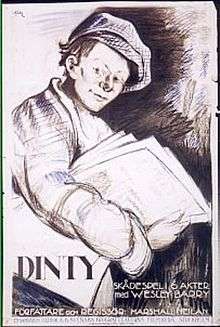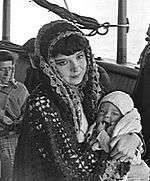Dinty (film)
| Dinty | |
|---|---|
 Theatrical release poster | |
| Directed by |
|
| Produced by | Marshall Neilan |
| Screenplay by | Marion Fairfax |
| Story by | Marshall Neilan |
| Starring | Wesley Barry |
| Cinematography | David Kesson |
| Edited by |
|
Production company |
Marshall Neilan Productions |
| Distributed by | Associated First National Pictures |
Release dates |
|
Running time | 73 minutes |
| Country | United States |
| Language | Silent (English intertitles) |
Dinty is a 1920 American silent comedy drama film written by Marshall Neilan specifically for Wesley Barry, a young actor known for his freckled complexion. Prominent among the supporting players were Colleen Moore, Marjorie Daw, Pat O'Malley, and Noah Beery.
The film is extant, archived in the Filmmuseum in Amsterdam.[2]
Plot
In a village in the Irish woods, young Doreen Adair (Colleen Moore) falls in love with a young man, Danny O'Sullivan (Tom Gallery). One day, Danny receives notice that he is offered a job in America. Before leaving, he marries Doreen. A year later, a son is born, and Doreen decides to follow her husband to America. Upon arriving in San Francisco from Ireland, Doreen discovers through Danny's landlady Mrs. O'Toole (Kate Price) that her husband has been killed in a car accident.
To support herself and her infant son Dinty, Doreen labors night shifts as a scrub woman until, at the age of twelve, Dinty (Wesley Barry) becomes the family's breadwinner by selling newspapers. Doreen, meanwhile, suffers from tuberculosis and gets weaker by the day.
Meanwhile, in Chinatown, when Judge Whitely (J. Barney Sherry) imprisons the son of opium smuggler Wong Tai (Noah Beery), Wong Tai retaliates by kidnapping the judge's daughter (Marjorie Daw). Dinty, whose work as a newsboy has familiarized him with the Chinese underworld, leads police to Wong Tai's hideout and saves the judge's daughter from a bizarre death by torture. As Dinty's mother has succumbed to tuberculosis, the grateful Judge Whitely adopts Dinty.
Cast


- Wesley Barry as Dinty O'Sullivan
- Colleen Moore as Doreen O'Sullivan
- Tom Gallery as Danny O'Sullivan
- J. Barney Sherry as Judge Whitely
- Marjorie Daw as Ruth Whitely
- Pat O'Malley as Jack North
- Noah Beery as Wong Tai
- Walter Chung as Sui Lung
- Kate Price as Mrs. O'Toole
- Tom Wilson as Barry Flynn
- Aaron Mitchell as Alexander Horatius Jones
- Newton Hall as The tough one
- Young Hipp as Wong Tai's son
- Hal Wilson
Production
In an earlier film, Go and Get It (1920), Barry played a supporting role as a paperboy named "Dinty". Neilan used the character to create a story in a similar vein as a starring vehicle for Barry, who was being groomed by the studio.[3]
Moore, on loan from Christie Film Company, would sign a lucrative contract with Neilan when production for Dinty was completed.[4] Anna May Wong appeared in an uncredited role that also led to more work with Neilan; after Dinty, he created a role for her in Bits of Life for which she earned her first screen credit.[5]
Portions of the film were shot on location in San Francisco including Chinatown and Adolph B. Spreckels' mansion.[1][5] The end of the film was shot on location on Catalina Island.[4] Sets were designed by Ben Carré.[6]
Release
Released November 29, 1920, Dinty was successful.[7][8] A booklet on Wesley Barry's life was put out concurrently, part of the movie's promotional strategy.[9] Neilan also used the release of Dinty to debut a campaign to improve the artistic quality of film stills.[10]
Reviews of the film were generally favorable. The Dramatic Mirror called it "a photoplay of remarkable direction, excellent acting ... and perfect photography".[11] The reviewer for Motion Picture News wrote: "There are enough elements in this feature to please every type of picturegoer."[12] Positive reviews appeared in trade papers Variety, Wid's, and the Exhibitors Herald.[13]
Some of the positive reviews were conditional. The Photoplay reviewer commented that Neilan's "human touch ... however obvious and conventional it may become, is usually effective". The New York Times critic noted the "deliberateness" that led to a deficiency in "genuineness", especially in the dramatic and action scenes.[14]
References
- 1 2 "Dinty". Catalog of Feature Films. American Film Institute. Retrieved 2015-03-27.
- ↑ "Dinty / Marshall Neilan". American Silent Feature Film Survival Database. Library of Congress. Retrieved 2015-03-27.
- ↑ Soister, John T.; Nicolella, Henry (2012). American Silent Horror, Science Fiction and Fantasy Feature Films, 1913–1929. McFarland. p. 231. ISBN 978-0-7864-8790-5.
- 1 2 Codori, Jeff (2012). Colleen Moore: A Biography of the Silent Film Star. McFarland. pp. 63–64. ISBN 978-0-7864-8899-5.
- 1 2 Chan, Anthony B. (2007). Perpetually Cool: The Many Lives of Anna May Wong (1905–1961). Scarecrow Press. p. 138. ISBN 978-1-4616-7041-4.
- ↑ Stephens, Michael L. (1998). Art Directors in Cinema: A Worldwide Biographical Dictionary. McFarland. p. 51. ISBN 978-1-4766-1128-0.
- ↑ McCaffrey, Donald W.; Jacobs, Christopher P. (1999). Guide to the Silent Years of American Cinema. Greenwood. p. 207. ISBN 978-0-313-30345-6.
- ↑ Slater, Tom (September 27, 2013). "Marion Fairfax". In Jane Gaines; Radha Vatsal; Monica Dall'Asta. Women Film Pioneers Project. Center for Digital Research and Scholarship, Columbia University Libraries. Retrieved 2015-10-06.
- ↑ "Neilan Ties Up on 'Dinty'". Motion Picture News. 22 (20): 3566. November 6, 1920. Retrieved 2015-10-05 – via Internet Archive.
- ↑ Shields, David S. (2013). Still: American Silent Motion Picture Photography. University of Chicago Press. p. 158. ISBN 978-0-226-01343-5.
- ↑ "Wesley Barry Makes Debut as Full Fledged Star" (PDF). The Screen. Dramatic Mirror and Theatre World. LXXXIII (2189): 1025. November 27, 1920. Retrieved 2015-10-06 – via Fulton History.
- ↑ "'Dinty': Melodrama and Sentiment Put This One Over". Motion Picture News. XXII (24): 4345. December 4, 1920. Retrieved 2015-10-06 – via Internet Archive.
- ↑ Variety review: Schader, Fred (November 26, 1920). "Dinty". Variety. LXI (1): 34. Retrieved 2015-10-07.
Wid's review: "Another Success for Neilan". Wid's Daily. XIV (56): 9. November 28, 1920. Retrieved 2015-10-07.
Exhibitors Herald review: "Wesley Barry in Dinty". Exhibitors Herald. XI (21): 85. November 20, 1920. Retrieved 2015-10-07. - ↑ Photoplay review: "Dinty—First National". Photoplay. XIX (3): 53. February 1921. Retrieved 2015-10-07.
New York Times review (reprint): "Here's Every Word of Every N.Y. Newspaper Review on 'Dinty' (ad)". Motion Picture News. XXII (25): 4398–4399. December 11, 1920. Retrieved 2015-10-07.
External links
| Wikimedia Commons has media related to Dinty (film). |
- Dinty at AllMovie
- Dinty at the Internet Movie Database
- Dinty at Silent Era website